Mark Sisson's Blog, page 298
May 31, 2014
Better Than Fried Chicken with Coconut Aminos Dipping Sauce
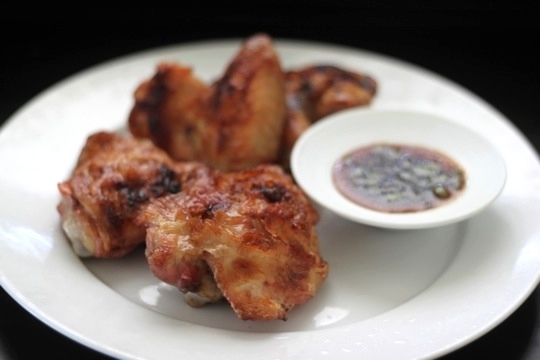 There are a lot of recipes out there for paleo/Primal fried chicken, all of them trying to create a crispy, finger-licking good coating using various nut and coconut products. This recipe isn’t for fried chicken, per se, but after tasting it you might give up trying to coat a piece of chicken in anything other than it’s own skin again.
There are a lot of recipes out there for paleo/Primal fried chicken, all of them trying to create a crispy, finger-licking good coating using various nut and coconut products. This recipe isn’t for fried chicken, per se, but after tasting it you might give up trying to coat a piece of chicken in anything other than it’s own skin again.
This is likely to be the crispiest baked chicken you’ve ever had, with skin that shatters when you bite into it. And, there’s no messy frying involved. The secret? Dredging the chicken in a mixture of egg whites, baking soda and salt, then letting the chicken air-dry overnight in the refrigerator. This genius method was perfected in Ideas in Food’s recipe for Korean-style chicken wings. The recipe here takes it one step further by not just using wings – drumsticks and thighs are just as delicious using this baking method.
This recipe also ditches the sweet and salty sauce from the original recipe and instead offers a completely Primal sauce made from coconut aminos, rice wine vinegar and toasted sesame oil. Brushing the sauce on the chicken just before it comes out of the oven makes the skin slightly less crispy, but adds lots of great flavor. The coconut amino sauce is also killer simply as a dipping sauce after the chicken is fully cooked.
This chicken is crispy, salty, sweet, totally finger-lickin’ good and totally Primal. Grab a piece right when it comes out of the oven, because it’ll barely make it to the table before it’s devoured.
Servings: 4 to 6
Time in the Kitchen: 1 hour, plus chilling the chicken overnight
Ingredients:

Idea’s In Food’s Chicken Coating:
3 large egg whites
2 teaspoons baking soda (10 ml)
1 3/4 teaspoons kosher salt (8.6 ml)
3 pounds skin on chicken wings, drumsticks and/or thighs (1.4 kg)
Coconut Aminos Dipping Sauce:
1/3 cup coconut aminos (80 ml)
1 1/2 teaspoon unseasoned rice vinegar (7.5 ml)
1 1/4 teaspoon toasted sesame oil (6 ml)
1 garlic clove, put through a press or very finely chopped
1 scallion, chopped
1/4 teaspoon or more red pepper flakes or hot chili oil (optional)
Instructions:
In a large bowl whisk together the egg whites, baking soda and salt. Add the chicken and toss really well to coat. Put the chicken on a baking rack set over a rimmed baking sheet, leaving space between each piece of chicken so none of the pieces are touching. You might have to use two pans. Refrigerate, uncovered, overnight.
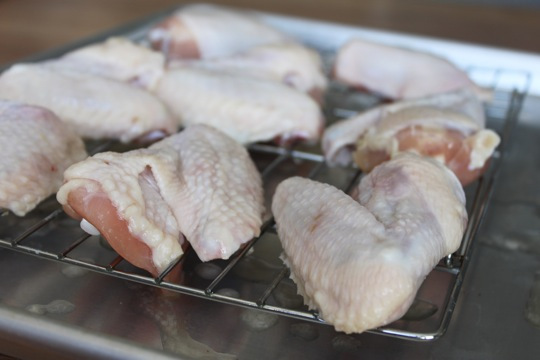
The next day, preheat the oven to 450 °F (232 °C).
In a small bowl, whisk together the coconut aminos, rice vinegar, toasted sesame oil, garlic clove, green onion and pepper flakes (if using). Split the sauce into two bowls. Use one bowl to brush the chicken during the baking process (optional) and one bowl to dip the chicken in after it’s cooked. Set both bowls aside.
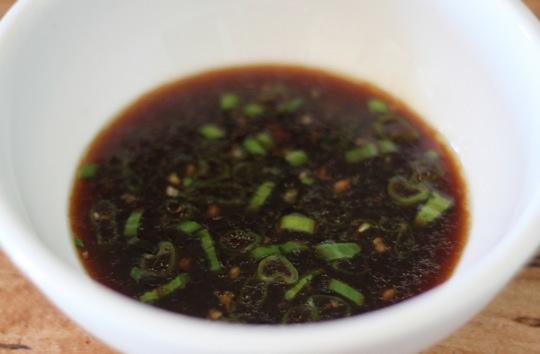
Leaving the chicken on the same racks and baking sheets, put it into the oven and cook for 15 minutes. Flip the chicken over and bake for 15 minutes more. At this point the meat should be pretty much cooked – thighs and drumsticks might take longer than wings, so make sure to use a digital thermometer to make sure the temp is getting near 165 °F before brushing on the sauce.
Brush both sides of the chicken with the coconut aminos sauce. Put the chicken back in the oven, skin side up, for 10 more minutes until the skin is nicely browned and crispy.
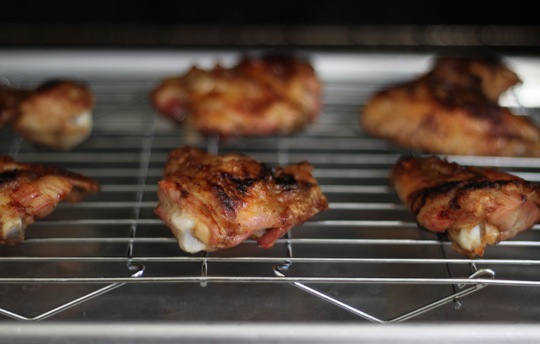
Serve the chicken immediately with the coconut aminos dipping sauce on the side.
This chicken tastes best if eaten soon after coming out of the oven. After a few hours in the refrigerator, the skin will no longer be crispy.

Not Sure What to Eat? Get the Primal Blueprint Meal Plan for Shopping Lists and Recipes Delivered Directly to Your Inbox Each Week




May 30, 2014
“The Healthiest Sick Guy” You Knew
It’s Friday, everyone! And that means another Primal Blueprint Real Life Story from a Mark’s Daily Apple reader. If you have your own success story and would like to share it with me and the Mark’s Daily Apple community please contact me here. I’ll continue to publish these each Friday as long as they keep coming in. Thank you for reading!
 Like most, I grew up playing sports in high school. I ate a “healthy,” low-fat SAD diet. Junk food was never allowed in the house. My only exposure to junk food was at friend’s houses. The closest I ate to cookies were graham crackers. Chips? No, we had dry saltine crackers.
Like most, I grew up playing sports in high school. I ate a “healthy,” low-fat SAD diet. Junk food was never allowed in the house. My only exposure to junk food was at friend’s houses. The closest I ate to cookies were graham crackers. Chips? No, we had dry saltine crackers.
I think my mom’s theory was, if it doesn’t taste too good, it can’t be that bad for you. She really tried. The first time my sister ate a cupcake she ate the wrapper not knowing it was there! You can’t make that kind of stuff up.
As a kid, I ALWAYS had stuffy sinuses and sore throats. I would develop bronchitis three to four times a year. To get to the bottom of it, an allergy test was performed. The results showed I was sensitive to dust mites (they live on everything, including us), cats, and dogs. We had all three.
The doctor’s orders were no pets in my room, and my pillows and mattress had to be wrapped in a plastic liner beneath the sheets. Nothing ruins a good night’s sleep like a noisy tarp under your head. It was fun convincing my friends I wasn’t a bed wetter. I swear I wasn’t. Really.
Entering my teens, bronchitis continued occurring even though I was following the bubble boy protocol. Strep throat became a yearly occurrence too. Maybe now it was my poor diet? Food at home remained “healthy,” but friends had cars and fast food was common.
Turning 18 I became what “non MDAer’s” would call a health nut. No longer participating in sports, I began working out, and eating “healthy.” I ate lots of veggies, heart healthy whole grains, and avoided saturated fat like the plague, no junk food whatsoever.
In college, alcohol consumption on the weekends became common. Everyone else drank but also ate terrible. Fast food, fried food in the dorm, late night pizza, alcohol, and yet they rarely got sick. One day my roommate said to me, “You’re the healthiest sick kid I know, you work out all the time, eat better than anyone I know, yet you’re always sick.”
I was lean and “in shape,” but he was right. Bronchitis and strep throat were still VERY common into my adult years. Z-Packs were like Tic-Tacs! Again determined to find out why, back to the allergist I went. There were no more cats or dogs, so what was it?
Between feeling like a swarm of fire ants were attacking me, and the red reaction patch on my back the size of a volleyball, I thought this time we had gotten to the bottom of it! I don’t remember the name, but was told I was allergic to pollen that “at certain times of the year gives people problems.” I found this odd because I had a year round problem.
Onward I went, “the healthiest sick guy” you knew. This label was discouraging; I was going to school for Exercise Science and wanted to help people become not only fit, but also healthy.
After graduating college I moved to Colorado to intern at a sport performance clinic. Nothing like elevation changes to let you know when your sinuses are acting up. One weekend, a visit from a friend led to a few nights with beers. By the time he left I woke with a familiar itch in my throat and stuffy sinuses. At this point in my life I rarely drank and wondered why alcohol affected me this way and not others?
It’s sad to think this was the “aha” moment (maybe getting drunk can solve your problems. Kidding). I wondered why I felt so bad and my friend didn’t. Maybe it was something in the beer? Our beer of choice that evening was a micro-brew wheat beer.
A few days of Googling wheat allergy symptoms led me to the Paleo diet, and eventually onto MDA. What I read seemed so simple and logical. Why was I only hearing about this now? I gave Primal a go, and a few weeks later my sinus congestion was gone! My daily morning phlegm, no more! That constantly itchy throat? Gone. I haven’t experienced bronchitis since. In fact, I hardly ever get sick.
Breathing better is huge. I’m a big hiker and love being outdoors. Today, if I consume wheat, the stuffy sinuses and itchy throat return. I haven’t tested it, but I’m confident if I continually ate wheat, bronchitis would return.

This journey has brought me more than the ability to breath. I sleep MUCH better now. I’ve never slept well in my life, EVER. I can’t state how much of an improvement this has been. My entire life I’ve dreaded going to bed, no matter how tired I am.
On average, I would lay in bed for one to two hours each night, regardless of what time I went to bed or how tired I was. That’s ridiculous, right? Now I easily fall asleep. No hitting the snooze button, I wake up refreshed.
Being an active person, I noticed another awesome change. The idea of “hitting the wall” disappeared. In high school I worried about getting what I called, “the rubber band body” during football practice. Essentially I was describing a blood sugar crash. Things change when your breakfast isn’t Honey Bunches of Oats, orange juice, and wheat toast with peanut butter and honey.
After moving to San Diego, I found a new and demanding hobby, Brazilian Jiu Jitsu. I get tired while training, but feel like I can train all day without ever hitting the wall and experiencing that “rubber band” crash feeling.
To this day my journey with food continues. I’ve joined local CSAs, began growing my own greens, and sourcing quality meat products (to the best of my finances). At times intermittent fasting has become an incredibly valuable tool.
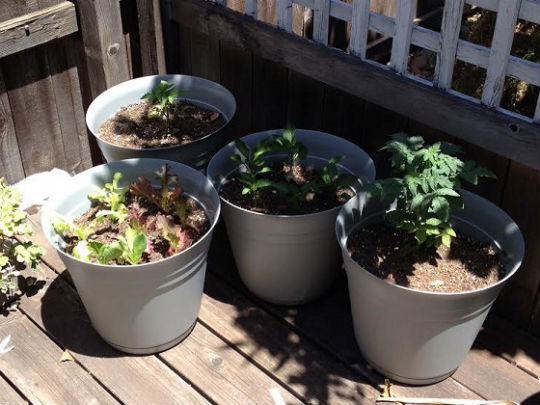

I used to require eight meals a day to function. Skipping a meal meant I’d become a dizzy, miserable, “hangry” monster. I would freak out! Imagine a seven-month old baby crying for food. Now imagine that baby being a 6 foot, 190 pound grown adult, capable of communicating with words about how hungry and miserable he feels. That should give you an idea of what I was like to be around.
Now, going ten hours without food while working an active day training clients, isn’t a problem. Hunger comes on slowly and steadily. It is a gentle reminder that it’s time to eat, not a complete code red, meltdown-system failure!
Obviously my personal health gains have been tremendously important to me. However, I want to say thanks for what this journey has helped me do professionally. As a personal trainer, the nutrition I promote now is far different than what it was after graduation. I’ve always understood that you can’t out train nutrition, and that is the first piece of advice I share with clients. The second is to check out a website called Marks Daily Apple.
Countless numbers of my clients, friends, and family members have regained control of their weight, energy, and relationship with food by using a Primal/paleo approach to eating. I’ve been so enthused about what eating this way has done for me, that it inspired me to share it in person. Last winter while visiting my family in Illinois, I hosted a fitness seminar that lasted three hours. Two of those hours were spent presenting the basics of eating a Primal/paleo diet; including recipes and the resources and tools to make it happen!
It was a great success! A handful of the group took the plunge and are experiencing amazing results first hand. Having resources like MDA, The Primal Blueprint, MDA success stories, and other leaders in the ancestral health community to point people towards, validated the nutritional suggestions made during the seminar. So Mark, thank you for that! You have created a ripple effect that you may not be aware is taking place!
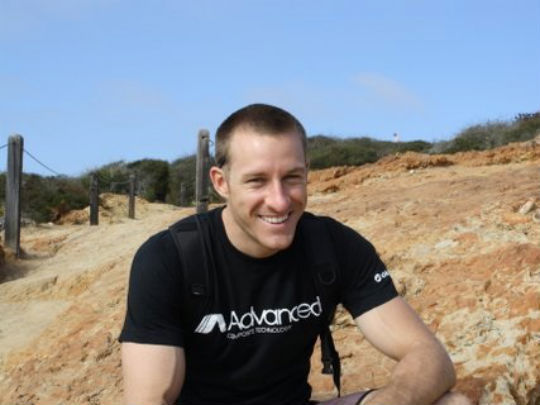
I also want to say thanks to the MDA community. It’s refreshing to read encouraging, positive, and inquisitive comments and discussion. Most places online, whether a YouTube channel, blog, or Facebook post, you can’t look past the first page without finding a rude, racist, degrading, or otherwise nasty comment. On MDA I see none of that! What a great place to send people who are looking for direction!
Luke
Join Mark Sisson and Friends in Sunny Southern California this Sept. 25-28! Get Your Tickets for PrimalCon Oxnard 2014 Today and Finally Meet Your Tribe!




May 29, 2014
Mastering the Art of Self-Negotiation
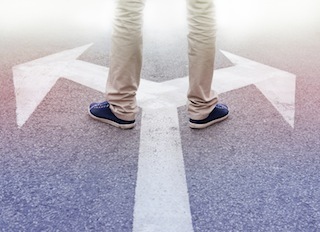 It happens to many – if not all of us at some point. You see an ad for pizza (insert other favorite non-Primal food) and find yourself fixated on a sudden and persistent craving. Most days you can look past it without much thought. Today is not one of those days. Sensory memory kicks into high gear, and the itch takes root. The inner dialogue of to eat or not to eat ensues. Your mind begins the trek down ye olde path of creative justification, and the trip is pretty well decided from there. “It’s been how many weeks/months since I ‘allowed’ myself to have pizza?” “I’ve eaten really well the last few days.” “It’s been a crappy day of putting up with x, y and z.” “I worked out a whole extra 20 minutes AND went for a morning bike ride.” “I seriously will only eat two pieces this time – seriously.” Within minutes, the argument has escalated into an urgent insistence to pick up the phone. A half an hour later, you’re digging in. Two hours later you hold a different view of those same negotiations and wish a mediator had been present, but the damage is obviously done. There’s the old tongue-in-cheek saying, “We’ve met the enemy, and he is us.” For all the shenanigans of the food industry, the slick tricks of marketing forces, the hard-nosed insistence of conventional wisdom and the guilt trips of those around us, we’re too often our own worst influences. The hardest voice to argue with will always be an internal one.
It happens to many – if not all of us at some point. You see an ad for pizza (insert other favorite non-Primal food) and find yourself fixated on a sudden and persistent craving. Most days you can look past it without much thought. Today is not one of those days. Sensory memory kicks into high gear, and the itch takes root. The inner dialogue of to eat or not to eat ensues. Your mind begins the trek down ye olde path of creative justification, and the trip is pretty well decided from there. “It’s been how many weeks/months since I ‘allowed’ myself to have pizza?” “I’ve eaten really well the last few days.” “It’s been a crappy day of putting up with x, y and z.” “I worked out a whole extra 20 minutes AND went for a morning bike ride.” “I seriously will only eat two pieces this time – seriously.” Within minutes, the argument has escalated into an urgent insistence to pick up the phone. A half an hour later, you’re digging in. Two hours later you hold a different view of those same negotiations and wish a mediator had been present, but the damage is obviously done. There’s the old tongue-in-cheek saying, “We’ve met the enemy, and he is us.” For all the shenanigans of the food industry, the slick tricks of marketing forces, the hard-nosed insistence of conventional wisdom and the guilt trips of those around us, we’re too often our own worst influences. The hardest voice to argue with will always be an internal one.
For some of us, our self-negotiation revolves less around food than other temptations. Maybe we get sucked into deep deliberation about staying up to watch another Netflix show or whether to have one more beer or whether we can take the day off from the gym (again). For every positive choice that affects our health and well-being, there’s at least one counter-argument that – in the murky waters of our mental workings can dissuade us from our good intentions. Is this your third night putting off a decent workout? But wait – have you noticed the number of intriguing Facebook posts, the compelling mobile-friendly news stories, the particular coziness of the couch this evening, the assured disappointment of a partner or family member presented with your absence (who is actually wondering why you haven’t left yet). Given enough time, that inner voice with its stunning myriad of angles and tactics could talk you out of your firstborn child, let alone a “leg day.”
Think about it. Who better knows our nuanced preferences or deep, dark weaknesses. Imagine a marketer with full knowledge of these inclinations and vulnerabilities – and the immense power it would offer. No wonder we’re master manipulators of ourselves. Sure, no one has as much to gain as we do from our good choices. We should be motivated by self-interest in these situations, but damn if we don’t also have the predisposition toward conniving and often sabotaging self-justification. With it, we find ourselves frequently drawn into these inner games of persuasion. How do we break out of these stalled talks and get the upper hand in our own self-negotiation?
Recognize that there are endless reasons to make a poor choice, and dump every single one of them.
Seriously here. Mark every one of them as excuses and promptly discard. Don’t give them time or space in your brain (because they’ll take over from there). If you need to, come up with a commanding image. Visualize an enormous rubber stamp with the word EXCUSE! in all caps with Zeus himself reaching down from the heavens to label each in an angry retort. Get up and do the next healthy thing. Don’t piss off the gods.
Stop arguing in the negative, and frame the choice within a positive outcome.
I shouldn’t stay up and watch another Game of Thrones episode because I’ll be tired and cranky in the meeting tomorrow. Correction: This is a truly awesome show, and I’ll look forward to another episode this weekend. In the meantime, my bed is calling my name, and I love spending a full night there, waking up with enough rest to enjoy my day. Another one… My rosacea/reflux//headaches/etc. will act up if I eat that brownie/burrito/waffle, and I’ll regret the decision for the next week. Correction: Yes, it looks good, but I love feeling good all the time and seeing what my body can do and how it can look when I feed it healthy food.
The point is this. Be prepared to continually pivot toward a positive result – a sense of accomplishment, a post-workout glow, better sleep, smaller jeans, amazing health, etc. A negative will always be a negative – sometimes an effective but not particularly inspiring “stick” we use to beat ourselves with in the hopes of better behavior. Drop the stick and drive yourself with positive vision.
Record those desired outcomes.
Whether it’s a list on your fridge, a couple pages in a journal, an elaborate vision board or a mindmap you did on a napkin three months ago, keep some written record of the outcome you want for your health. Cover the bases: the kind of fitness level you want, the kind of sleep you want, the kind of stress-resistant mentality, the diet you want, the body you want, etc., etc. When all those “good reasons” to make a poor choice come beating at your door, go to your visual and get that feedback without having to conjure all the thinking in the moment. Don’t depend on immediate reasoning every time you encounter temptation in the here and now. Let your notes (or visual) think beyond the present moment for you, and use them as often as need be to redirect.
Limit the need for negotiations – period.
This tactic is more important for some of us than others. For beginners or those looking to make radical change, it can be key. Fend off the stress and complication of self-negotiation by sticking to routine whenever it makes sense, by simplifying your life, by editing a day’s influences (e.g. social media, advertisements, negative people, etc.) and by creating a healthy life you look forward to living out each day rather than one you’re constantly disciplining yourself to stick to. If you have to ride herd on yourself every day, maybe your willpower isn’t the problem.
Thanks for reading, everyone. How do you practice (and win at) the art of self-negotiation? Share your thoughts, and have a great end to the week.
Not a Subscriber? You Are Missing Out. Subscribe for Free Today and Instantly Get 8 Primal eBooks and So Much More!




May 28, 2014
Beyond Sugar and Soda: Nutritional Cures for Damaged Teeth
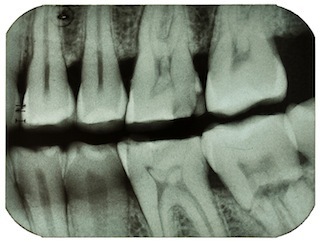 This is another special guest post from our favorite study-dismantler, Denise Minger. Read all of her previous Mark’s Daily Apple articles here, here, here, here, and here, pay her website a visit, and grab a copy of her new book Death by Food Pyramid: How Shoddy Science, Sketchy Politics and Shady Special Interests Ruined Your Health. Enter Denise…
This is another special guest post from our favorite study-dismantler, Denise Minger. Read all of her previous Mark’s Daily Apple articles here, here, here, here, and here, pay her website a visit, and grab a copy of her new book Death by Food Pyramid: How Shoddy Science, Sketchy Politics and Shady Special Interests Ruined Your Health. Enter Denise…
When you’re a teenager, a tad cocky about your flossing-and-brushing prowess, and a proud worshipper at the altar of Colgate, the last thing you want to hear is that you might need dentures by the time you’re thirty.
Unfortunately, that’s the exact situation I found myself in one fateful November day. I was seventeen. It’d been a full year since I’d become a strict, low-fat, fruit-noshing raw vegan — led there by a cocktail of food allergies and dewy-eyed trust in people from the internet (bad idea is bad). Perhaps too distracted by my constant brain fog, perpetual shivering, and the clumps of hair making a mass exodus from my scalp, I’d failed to notice the prime victim of my lopsided diet: my teeth.
Up until then, I had pleasant associations with the ol’ dental chair. My mouth had only ever seen one cavity — a fluke in an otherwise pleasing track record. I’d never missed a day of flossing. I’d never needed braces. For me, dentist visits were an opportunity for people to tell me nice things and make me feel good about myself, even if I’d gotten too old for their goodie drawer of parachute men and Lisa Frank stickers.
So when that familiar praise didn’t come, the blow was all the more devastating. After a series of “hmms” and heavy sighs, my dentist delivered the news: a grand total of sixteen cavities — more of an estimate, really, because the cavities-sprouting-from-cavities nature of the damage made it hard to count. Massive wear capped the surfaces of my back teeth, and my front ones were becoming translucent from enamel loss. Unsightly recession plagued my once-healthy gums.
The dentist didn’t mince words when telling me he’d never seen someone so young with such a terrifying mouth — and it’d all happened in the span of one year.
The next few months involved five trips back to that same chair: four to drill the heck out of all the quadrants of my mouth, and one to grind down the misaligned bite I’d acquired from my new ceramic fillings. But that was only the beginning. Nearly as soon as I’d gotten the old cavities cleaned up, new ones started forming. My teeth continued their rapid decline. The bacteria-filled “gum pockets” crawled deeper from bone loss. I knew a drill wasn’t going to be enough to save me.
To this day, I’ve never seen a group of people with such rapidly imploding dental health as the raw vegans. Even studies of their pearly whites seem to confirm that. It’s like some sort of hazing ritual, in which the Cavity Fairy comes and sprinkles decay upon the mouths of new recruits. But the problems I encountered as a raw vegan were far from unique to meat-free, non-cooking mouths, and neither were the solutions I eventually found. For most of us, even those of a real food/primal/Paleo/ancestral persuasion, decades of subpar eating, overzealous brushing, and other teeth-harming practices have left us with some damage to fix. It’s my hope that sharing the details of my own healing journey will help some of you on yours.
(This is probably the part where I should insert a disclaimer to protect my patooty from a lawsuit: dental problems can be quite serious, and if you’re experiencing something debilitating or extremely painful or infection-related, you should probably head to a dentist instead of reading this. Also, floss. Just do it.)
Zig-Zags and Prongs
Let me make one thing clear: my road to healing wasn’t linear. It had lots of loop-de-loops and mistakes and nights spent staring in the mirror, lips rolled over my teeth, convincing myself I would still be an okay person if I looked like Gumby. There were moments after trying things I was sure should work — adding more calcium to my diet, cutting down on fruit, eating pounds of kale — where I almost threw in the towel and resigned to a life of oral misery.
But eventually, I went from embracing mainstream beliefs about dental health — that cavities can’t heal, that calcium is the biggest tooth-relevant nutrient, that candy and soda are the only foods you need to worry about — to doing a 180 on all those fronts, and feeling pretty confident in the ability for teeth to regenerate. For anyone out there who’s struggling with dental issues, no matter how severe, don’t give up hope.
Ultimately, my own tooth-healing saga, as accidental and fumbling as it was at the time, became something of a two-pronged approach. The first prong was protecting my chompers from the outside in, minimizing sources of external damage. The second prong involved rebuilding my teeth internally, with many delicious things. (That prong was a lot more fun.) Here’s the full story.
Protect and Defend
In real-food circles, when you see an article about fermented foods, usually there are lots of exclamation points and pictures of beautiful bubbly sauerkraut, and testimonies about the slew of benefits those fermented things brought, and there is happiness. So much happiness. For that reason, what I’m about to say might get me booed off the cyber-stage:
Fermented foods wrecked my teeth.
Okay, that’s a bit hyperbolic, especially considering my teeth were already wrecked to begin with. But when I unveganized, as part of my early healing attempts, I went hog wild on all things kimchi and sauerkraut — convinced the beneficial bacteria would do something awesome for my teeth and hair and everything else on me that was broken.
What happened instead was pain, and lots of it. I used to sit at the kitchen table with a heaping bowl of gingery, zangy, raw, delightful kimchi, convinced it was the best thing I could be forking into my mouth. A few bites in, my mouth would seize up with sharp, dagger-like pain, evocative of what it might feel like to give birth through one’s jaw while also being electrocuted. The pain was so bad that it made “dentures by the time you’re thirty” sound like a pretty good idea.
Perhaps it was my raging kimchi addiction that kept me blind to reality, but it took months of wincing before I realized those fermented veggies were making my teeth more sensitive, and worsening the damage I was desperately trying to fix. And after a little research, it was easy to see why: sauerkraut and kimchi have a pH of about 3.5, making them extremely acidic upon contact with your chompers — and capable of chewing through enamel with the best of ‘em. That’s about the same pH level as soft drinks like Coke and Pepsi.
(High-school science refresher, in case you slept through that lesson: a pH of 7 is considered neutral; anything higher is alkaline, and anything lower is acidic. Foods with pH levels below 5.3 start entering the “enamel damage” territory, especially if your teeth are already in a compromised state.)
Not surprisingly, my tooth pain resolved pretty fast after I started limiting fermented vegetables and other highly acidic foods, especially fruits I hadn’t realized had such a low pH. I can eat those things now without any problem — at least in moderation; I still have to keep my inner kimchi-gorger in check — but during the early phases of healing, I had to be pretty cautious about giving my mouth an unintentional acid bath.
In case you’re curious, here’s a list of some of the low-pH foods that ended up on my “limit” list for a couple of years. You’ll notice a lot of fruit on there. Given that my own teeth healing occurred with a diet packed with low-acid fruits (papaya and melons, largely), I tend to think the acidity of fruit is a bigger problem than its sugar content, as far as dental health goes. (Values taken from a list produced by the FDA.)
Apples: 3.3-3.9
Apricots: 3.3-4.0
Blackberries: 3.9-4.5
Blueberries: 3.1-3.3
Cherries: 3.2-4.1
Frozen cherries: 3.3-3.4
Dill pickles: 3.2-3.7
Grapes: 2.8-3.8
Grapefruit: 3.0-3.8
Ketchup: 3.9
Lemon juice: 2.0-2.6
Lime juice: 2.0-2.8
Mangoes: 3.4-4.8
Nectarines: 3.9-4.2
Olives (green, fermented—black fresh or canned ones have a pH of at least 6): 3.6-4.6
Peaches: 3.3-4.1
Pears (Bartlett): 3.5-4.6
Pineapple: 3.2-4.0
Plums: 2.8-4.5
Pomegranate: 2.9-3.2
Raspberries: 3.2-3.7
Sauerkraut: 3.3-3.6
Strawberries: 3.0-3.9
Tangerine: 3.3-4.5
Tomatoes (canned): 3.5-4.7
Vinegar: 2.4-3.4
Orange juice: 3.3-4.2
Red wine: 3.4
White wine: 3.0
Along with limiting acidic foods, I picked up a few other tricks of the trade to protect my teeth from outside invaders. I stopped brushing immediately after meals (apparently, scrubbing enamel before it remineralizes is no bueno). If I did have a moment of weakness and invade the kimchi jar, I would swish afterwards with water and baking soda to raise my mouth’s pH. Boom! Sensitivity averted. And instead of using whitening toothpastes or other commercial whiteners to combat stains from chain-drinking tea, I started brushing with activated charcoal, which is gentle and miraculous. Seriously. I’m not kidding. It’s amazing.
But those things were only bandaid fixes — ways to prevent my teeth from getting worse, but not really doing much to help them heal. The other leg of my journey was nutritional.
Rebuilding: A Triage of Fat-Solubles
As a vegan, it is, by several universal laws, a requirement to hate the Weston A. Price Foundation. It doesn’t really matter why that hatred is there, so long as it’s strong and vocalized at every relevant opportunity.
In my case, even after my departure from veganism, I maintained my WAPF-hating duties like a champ. How dare they put a picture of happy people on their webpage! How dare they eat butter! How dare they use… words… and colors. Despicable. I gradually ran out of reasons for my loathing, and after seeing virtually no improvement in my teeth after guzzling calcium supplements and dark leafy greens, decided to peruse their articles on dental healing. That’s when the pieces started clicking together in a big way.
As I learned from a few WAPF articles, three fat-soluble vitamins — A, D, and K2 — tend to be the holy trinity for all things teeth. I wrote a bit about these nutrients on an earlier article directed towards raw vegans, but the nutshell version is that they work synergistically to support bone and tooth health, boost calcium absorption, and shuttle calcium where it needs to go. My own experience confirmed what I’ve heard time and time again from other self-healers of teeth: this combo works some small miracles.
(A special note on K2: hopefully everyone in this little corner of the food world has heard about this lovely nutrient, but if you haven’t, you owe yourself a research safari. A great book on the topic is “Vitamin K2 and the Calcium Paradox” by Kate Rheaume-Bleue, and plenty of online resources abound — including some earlier posts here on Mark’s Daily Apple.)
During Operation Save My Teeth, before I knew anything about fat-soluble vitamins, one of the first non-vegan foods I’d added to my diet was “probiogurt” — a raw, 30-hour fermented goat yogurt I ordered from a farm in Austin. It was also the first food that actually pleased my pearly whites: within a week of adding it to my diet, the translucent tips on my teeth became more opaque, and my nagging, chewing-induced sensitivity began to quell. Unfortunately, I’d stopped eating the yogurt on account of the farm becoming terrible and scammy and no longer shipping the orders I’d paid for.
At the time, I figured the yogurt’s benefit had just been from its calcium content, and was genuinely baffled when supplementing didn’t do diddly squat. Oh, ignorance.
Enter the WAPF website and its vitamin K2 revelations. Epiphany time! As I read about this precious nutrient, it suddenly made sense: vitamin K2 is a product of bacterial fermentation, and the “probiogurt” I’d been eating was likely teeming with it. It was probably the first food-based source of K2 my body had seen in years. After that “aha” moment, I started religiously supplementing with vitamin K2 — 5 milligrams a day from Carlson Labs. (That’s still the brand and dosage I use to this day.)
Shazzam. Practically overnight, my teeth felt smoother, looked whiter, and lost a great deal of their painful sensitivity. And at my next dental cleaning, the hygienist confirmed a turn for the better: some of my “irreversibly” lost enamel was thickening; a few pre-cavity trouble spots were filling in on their own; and the periodontal pockets that’d been getting gradually worse were suddenly tightening back up — jumping from measurements of 4-5 millimeters on most teeth to 2-3. My lost-cause mouth was suddenly not so lost. Allow me to repeat: shazzam!
(Apart from supplementing, other K2 sources include natto, hard cheeses, soft cheeses, butter from pastured cows, egg yolks, liver, and probably other organ meats — K2 analyses are pretty sparse for most foods. Since I don’t do dairy anymore, my main non-pill source is liver. Speaking of which…)
Along with vitamin K2, one of the most pivotal edibles in my dental saga has been liver. As far as “building strong bones” goes, I’m pretty sure those Got Milk? ads should feature people with paté moustaches instead of milk smears, though something tells me that might ding sales. I really can’t praise liver enough. Along with being a decent source of vitamin K2, it’s awesomely high in vitamin A — something in short supply on vegan diets and even some omnivorous ones, depending on how wisely the animal foods are selected.
For the last few years, I’ve wobbled back and forth between taking cod liver oil (this kind’s my favorite) and eating free-range chicken liver a few times per week, and the result is the same: the benefits I already see from taking vitamin K2 get an even bigger boost. Whiter color, smoother tooth surface, less plaque build-up, less sensitivity, happier hygienists when I go in for a cleaning. When I slack off on the liver too long, my teeth are the first to chide me for it.
And last but not least, the third member of the fat-soluble gang: vitamin D. As a resident of the gorgeous but gloomful Northwest, vitamin D has been a lifesaver for me, maybe literally. After I moved out of Arizona in 2008 and landed in Portland, I started taking between 1,000 and 3,000 IU of vitamin D per day, depending on how quickly I manage to dash outside when the sun makes its forty-second cameo appearance. (There are plenty of feuding opinions on the best dosage, but in terms of maintaining the state of my teeth, that’s been my sweet spot.) Although the benefits I’ve experienced from vitamin D have been most noticeable in the realm of mental health (e.g., taking it helps me not be a Seasonal-Affective-Disordered zombie from October to March), I’ve noticed a decline in the state of my teeth when my bottle runs out and I don’t replace it for a few weeks. So, on my shelf it stays.
Flash Forward
It’s been a whoppin’ decade since I took my first bite away from raw veganism and towards better health, and seven years since the condition of my teeth really stabilized in a happy place. Of course, my mouth will probably never return to the pristine state it once held; I still have ups and downs when I’m not vigilant with the fat-solubleness of my diet, and I need more frequent cleanings than the average bear. But I’m 27 now, and all the teeth in my mouth are still mine. In three years, I expect it’ll still be that way.
(And if not, I’ll totally become that crazy lady who whips out her dentures at random moments and frightens the children. Win-win.)
Learn More About Denise Minger’s New Book Death by Food Pyramid: How Shoddy Science, Sketchy Politics and Shady Special Interests Ruined Your Health Here>>




May 27, 2014
7 Nighttime Rituals to Help You Unwind, Relax, and Chill Out (That Don’t Involve Alcohol)
 Last week, I shared my evolving relationship with alcohol. I’m off it, basically. A big change has been at night; a glass or two of wine with Carrie used to be my nighttime ritual. It would help me unwind from a stressful day, relax and reconnect with my wife, and get me ready for bed. So when I decided to give up alcohol – or at least make it an occasional rather than regular indulgence – I knew I had to figure out another way to unwind before bed. I haven’t really settled on anything yet. I’ve only explored some of the research on nighttime unwinding and thought I’d share my findings with you.
Last week, I shared my evolving relationship with alcohol. I’m off it, basically. A big change has been at night; a glass or two of wine with Carrie used to be my nighttime ritual. It would help me unwind from a stressful day, relax and reconnect with my wife, and get me ready for bed. So when I decided to give up alcohol – or at least make it an occasional rather than regular indulgence – I knew I had to figure out another way to unwind before bed. I haven’t really settled on anything yet. I’ve only explored some of the research on nighttime unwinding and thought I’d share my findings with you.
I’m not going to include routine, everyday advice like “Read a book” or “Have sex” or “Listen to calming music,” despite their effectiveness. You already know about them so it would just be redundant (but do them nonetheless!).
Even though I just discussed the importance of breaking up a routine before it becomes a rut, routines are excellent tools for establishing habits and ingraining positive conditioning. If you do the same thing before bed to unwind and prepare for sleep, your body will associate that thing with unwinding and sleepiness. That’s not a rut. That’s a win.
Let’s get to the rituals.
Sit around a fire.
The best part of camping is always the campfire at the end of the night. You’re there under the stars, usually with loved ones, close friends, and just enough soft light to see their faces. You pass around stories and laughs until that comfortable silence settles in. And you just stare into the flames. For hundreds of thousands of years, humans (and even the ancestral hominids that also controlled fire) capped off the night by staring into the very same fire you have today. As time has gone on, the radio, the TV, smartphones, tablets, and laptops have replaced fire as the glowing source of energy we stare into at night, but wild unadulterated fire still works best. Plus, firelight is naturally low in circadian-disrupting blue light.
Use the fireplace, build a fire pit out back, light a bunch of candles – just make it a point to look at fire.
Smell something nice.
However fraught with controversy and potentially confounded by placebo effects, aromatherapy has been used for thousands of years to reduce stress and promote relaxation. And modern clinical evidence suggests that the scent of certain essential oils can reduce stress. Take lavender, which increases parasympathetic activity and improves sleep in insomniacs, lowers nighttime blood pressure and improves self-reported sleep in hospital patients, and reduces anxiety and improves sleep in intensive care patients. Even if it is placebo, does it really matter? The whole point of a bedtime ritual is to plug into the power of placebo to “trick” your body into getting ready for sleep.
Lavender looks to be the essential oil with the most efficacy. Something like this works well.
Give a massage.
Receiving a massage is a fantastic stress-reliever, and it would be ideal if everyone, everywhere, received nightly massages. I’d imagine c-reactive protein levels would drop and sleep quality would universally improve. It could be the single most revolutionary health measure ever taken. Unfortunately, getting a massage means paying for one or convincing your significant other or friend to give you one. Some of you may be lucky enough to be in a position where that’s possible, but most are not. But what if you gave a massage to someone at night? What if you offered it up on a regular basis? No one’s going to turn you down, and research suggests that people who give massages receive multiple benefits. For one, you’ll feel less anxious. Two, a good massage artist (even an eager amateur) treats their work like a meditation; you must be mindful of what you’re doing as you’re doing it and pay close attention to the interplay between your hands and their skin, fascia, and musculature. Three, giving a massage to someone makes that person far more likely to return the favor.
This is an easy one – just offer a massage to someone you’re willing to touch. They very rarely decline. You could take some lessons or find an online massage guide, but simply exploring their body while taking care to pay attention to the feel of their tissues is a good enough start.
Tell stories.
The human tongue and vocal cord aren’t only good for basic communication about mundane topics relevant to immediate survival. Humans are born storytellers. No, we don’t all have the ability to paint verbal pictures or keep a crowd of thousands enthralled, but we can relay simple narratives. We can read out loud. We can build stories with a partner by trading off, one line at a time. Even the humdrum daily “how was your day?” chat we all have with our roommates and loved ones is a form of storytelling, so that will work, too. Storytelling or reading books to your children before bed results in improved sleep duration and better cognitive development, and I’m convinced those benefits are maintained in adults who hear and tell stories at night. Whether you’re telling or hearing the story, you’re in another place – far from the daily stressors that make unwinding so difficult and so necessary.
If you don’t have any good stories handy, start by just telling someone about your day. And if you don’t have anyone to discuss your day with, keep a journal or write it down. It’s being in “storytelling mode” that probably matters, whatever the medium you use to tell it or hear it.
Prepare tea.
Historically, tea preparation is highly ceremonial. I would recommend against a 4-hour Japanese chaji if you’re trying to get to bed at a reasonable time, but you can certainly come up with your own condensed tea ceremony. Or if formality doesn’t interest you, at least pay attention to the details as you brew it: the steam’s hiss, the sizzle of the water against the pot, the initial rinsing of the tea, the first sip, the “aaaaah.” This will become a routine or a series of sensations that can help signal bedtime to your body (provided you avoid caffeinated teas, of course). And that’s not even getting into the potential psychoactive effects of various teas, many of which can induce relaxation and sleepiness while reducing anxiety and stress.
I wrote about several such teas in a series of two posts (here and here). Go check them out, order some of the teas, and give the nighttime tea ritual a shot.
Practice your breathing.
If you recall from yesterday’s Dear Mark on the acid/base balance, the primary way we expel excess acids is through the ventilation pathway. By inhaling oxygen and by exhaling carbon dioxide, we maintain homeostasis. But breathing also impacts our anxiety levels. Short rapid breaths both increase and indicate anxiety and stress, while calm, slow, deep breaths that incorporate the diaphragm – not just the chest – are soothing. They trigger the parasympathetic response that reduces stress and anxiety.
Instead of chest breathing, try breathing through your chest and belly. Focus on expanding your ribcage and settling into the breath. Relax your abs and don’t suck in your stomach. Take it slowly – this isn’t a race – and breathe deeply. Try to inhale and exhale smoothly, free of judders. As you may discover, breath practice often turns into a sort of meditation. That’s totally fine.
Move around.
For some, it’ll be a quick sprint out in the street or some Tabata intervals on the exercise bike. Others will relax by hitting a deadlift PR, calm and smooth and zen-like. It all depends on how you respond to the movement. Personally, heavy lifting gets me amped. Anything intense, actually – sprints, metabolic conditioning, Ultimate Frisbee – will energize and prevent me from sleep anytime soon. And going for a walk or hike just before bed makes my mind go. If I do that, I’ll typically stay up writing or thinking about the grand new idea I happened upon. Believe it or not, what I like to do these days before bed is a bit of yoga. What kind? Who knows. I cycle through a few random poses that Carrie’s showed me and they seem to work. I don’t think the specific pose itself is as important as just doing a few, if that makes sense. According to the research, yoga certainly reduces anxiety (more than walking) and improves quality of sleep, probably by increasing GABA levels.
Most people will unwind more effectively using “gentler” movements like stretching or yoga. But a few of you will probably benefit from more intense exercise, especially if you’re coming off a particularly grueling day and you just need to blow off some steam. Try different ones out to see what fits and stick to it once you’ve settled. Remember, it’s all about the routine.
That’s what I’ve got, folks. How about you guys? What routines, habits, or rituals do you use to unwind at night?
Get the 7-Day Course on the Primal Blueprint Fundamentals for Lifelong Health Delivered to Your Inbox for FREE




May 26, 2014
Dear Mark: Does Dietary Acid/Base Balance Matter?
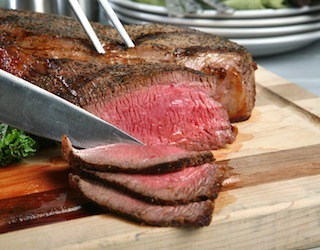 For today’s Dear Mark, I’m covering just one topic: the relevance of acid/base balance to health. Anyone wading through the morass of Internet diet information has come across the idea than an excess of acidity derived from our diet overloads the body’s ability to balance it with alkalinity. A diverse group invokes it, including strict paleo dieters, vegans grasping for straws to indict meat, and web sites featuring HTML from the 1990s that sell alkalizing water tablets. And because acidity sounds caustic and vaguely negative, lots of people buy into it. So, does it matter?
For today’s Dear Mark, I’m covering just one topic: the relevance of acid/base balance to health. Anyone wading through the morass of Internet diet information has come across the idea than an excess of acidity derived from our diet overloads the body’s ability to balance it with alkalinity. A diverse group invokes it, including strict paleo dieters, vegans grasping for straws to indict meat, and web sites featuring HTML from the 1990s that sell alkalizing water tablets. And because acidity sounds caustic and vaguely negative, lots of people buy into it. So, does it matter?
Let’s go:
I often hear about the acid-alkaline properties of foods in the comments and forums. However, I am not sure if this has any scientific merit. You don’t seem to have any posts about it so would you care to shed some light on the matter?
Hashim
Human blood likes to have a pH between 7.35 and 7.45, slightly above neutral. If pH dips too low and our blood becomes acidic, our cells stop working. This is called metabolic acidosis, and it comes in two flavors – acute and chronic. Left untreated, acute acidosis will kill you, while chronic acidosis leads to a host of health conditions that will eventually kill you or at least erode your quality of life:
Hypothyroidism
Muscle wasting
Bone loss
Glucose intolerance
Growth hormone resistance (which can retard growth in kids)
When we metabolize foods and nutrients, some of them produce acids as byproducts. Acid-producing foods include meat, fish, grains, legumes, and dairy. They therefore represent a “high acid load,” and avoiding a high acid load is one of the main reasons many plant-based health types recommend avoiding animal foods. Our bodies, you’ve probably heard, just can’t handle the acidic fallout of all that meat and dairy without falling into metabolic acidosis.
Actually, the body has several ways to maintain the optimal pH range and avoid health problems in the face of acid-forming foods – and they’re extremely effective. If they weren’t, we’d be dead.
One way is through basic respiration – breathing. The lungs monitor the pH of our blood, prompting faster breathing when acidity needs to drop and slower, deeper breathing when acidity needs to rise. By exhaling carbon dioxide, we expel excess acidity. This is the primary way we compensate for fluctuations in pH.
Another way is through the kidneys. When acidity is high, the kidneys excrete more acids and produce bicarbonate, which returns to the blood as a buffering agent. Buffering agents combine with acids in the blood to neutralize them for easier excretion. There are other buffering agents, but bicarbonate is the primary one.
Yes, blood pH is tightly and most importantly unconsciously regulated. As long as your kidneys and lungs are working, the foods you eat will neither lower nor raise the acidity of your blood. What about those urine sticks that measure pH? Altering urinary pH with the food you eat is easy enough, but it doesn’t reflect blood pH. In fact, “acidifying” one’s urine by eating “too much” meat is proof that your kidneys are doing their job and excreting excess acid from the blood.
Thus we invalidate the most drastic claim about pH and health – that an acidic diet promotes acidic blood which promotes cancer. The body’s pH is maintained in a narrow range, regardless of the food you eat. Since its proponents are never able to cite any direct evidence beyond a misinterpreted Otto Warburg quote, I never put much stock in this claim.
But the next claim sounds more plausible: maintaining optimal pH in the face of acid-forming foods requires a calcium buffer that we leach directly from our bones. This leads to osteoporosis and the eventual dissolution of our entire skeletal system until we’re nothing but a disembodied urethra spewing brittle bone paste. Okay, that last part I made up. No one says that (I hope). There is evidence that appears to support the claim, which is why this idea has so much traction. First, consumption of the most acid-forming food of all, protein, does increase calcium excretion in the urine. And second, exposing in vitro bones to a metabolic acidosis test tube environment results in mineral dissolution, calcium loss, and production of the prostaglandins involved in osteoporosis.
Superficially, it’s compelling.
The entire premise falls apart when you look at the actual effects of consuming the most acid-forming food of all – protein – on the bones of real live humans. What happens to your bones when you eat protein? Although eating acid-forming protein often increases urinary calcium, it has an overall beneficial effect on bone metabolism and acid/base balance:
Dietary protein increases intestinal calcium absorption. Maybe it’s because the body “knows” it’s about to consume some bone-destroying acid-forming meat or whatever, but studies consistently show that eating protein also increases the amount of calcium we absorb. This is at least partially due to specific amino acids within the protein. At any rate, with more calcium available to the body, more will be excreted.
Dietary protein has no effect on bone resorption. Bone resorption is the removal of calcium from bone. If acid-forming protein were leaching calcium from your bones, resorption markers should be increasing. They don’t. Studies consistently show that eating protein has no effect on bone resorption.
Dietary protein increases renal function. People with existing renal insufficiency are often advised to lower their protein intake, but in healthy people with normal kidney function, eating sufficient protein is important for maintaining that function. By providing ammonia substrates, protein actually increases the kidney’s capacity to do its job and excrete acids.
The same goes for dairy, another acid-forming food that gets a ton of flack from many online health communities for its supposedly bone-dissolving effects. In truth, dairy is good for bone health. Maybe it’s the phosphate, which has been shown to reduce calcium excretion in the urine and improve calcium balance in the body. Or it could be the vitamin K2, a vital bone nutrient found in whole fat aged cheeses that improves bone mineral density in osteoporotic patients. Maybe it’s the dairy protein, which increases calcium retention and reduces bone calcium resorption while improving bone mineral density. Even when you add acid-forming dairy protein to a diet that’s already replete in acid-forming protein, it has no effect on bone mass or strength. There’s also the calcium to consider, along with the synergy of all the listed nutrients.
So it’s unsurprising that a diet high in meat and other acid-forming foods increases calcium absorption and excretion while lowering parathyroid hormone (a hormone usually elevated in osteoporosis).
If there is a problem with acid load, it’s only in people with renal insufficiency. Outright kidney failure can obviously cause metabolic acidosis, and it’s possible that gradually declining kidney function results in problematic low-level acidity. Kidney function certainly tends to decline with age, while the risk of fractures increases. Despite that weak connection between old age and renal insufficiency, seniors who eat more protein still have better bone calcium retention and absorption.
I’m not arguing that the acid/base balance of our blood isn’t important. It is. I’m arguing that the healthy among us are unable to consciously alter it, whether through the foods we eat or sheer will. And I’m arguing that some of the most acidic foods – meat and dairy - tend to have the most beneficial effects on bone health. Eating a purely acidic diet isn’t a good idea, but that’s because you’d be eliminating a ton of healthy plant matter with important nutrients, not because of the effect it has on your blood acid/base balance.
The weight of the evidence is clear: the acid-load of the diet has no effect on bone health in healthy people.
Thanks for reading, all.
Like This Blog Post? Dig Deeper with Primal Blueprint Books and Learn How You Can Reprogram Your Genes to Become Leaner, Stronger and Healthier




May 25, 2014
Weekend Link Love
 Episode #20 of The Primal Blueprint Podcast is now live. I get back into the flow of answering reader questions with a bunch of fitness-related queries. If you have any questions of your own, or perhaps some ideas for future podcasts, please let me know by using the blue “Submit a Question” button in the sidebar!
Episode #20 of The Primal Blueprint Podcast is now live. I get back into the flow of answering reader questions with a bunch of fitness-related queries. If you have any questions of your own, or perhaps some ideas for future podcasts, please let me know by using the blue “Submit a Question” button in the sidebar!
Research of the Week
Yet another potential disruptor of the intestinal microbiome looms: disordered sleep.
Vinegar is a surprisingly healthy food.
The form of vitamin E found in canola, corn, and soybean oil may increase the risk of developing asthma and decrease lung function.
Interesting Blog Posts
Declining biodiversity in the environment isn’t just bad for the plants, animals, and microbes that get cut. Since humans derive physiological benefits from observing nature’s diversity, it could also destroy our mental health. Imagine the horror of wild, savage nature replaced by one long, unbroken, perfectly manicured front lawn.
The dolphins and orcas at Seaworld aren’t the only mammals that have to worry about diseases of captivity.
Media, Schmedia
Treadmill desks get virtual ink in Forbes.
A pretty decent article from the Huffington Post: nine habits of people with a healthy relationship to exercise.
Everything Else
Remember that Australian two-part series discussing the downsides of statins and the misguided attack on cholesterol from awhile back? ABC Australia is pulling it.
How skipping soap and rubbing bacteria all over your body can keep you clean.
A parasite that forces its host to dig its own grave.
Beautiful photos of a dwindling population of sea nomads.
A nice way to protect your frying oil from oxidative damage.
How gluten might affect child development.
Recipe Corner
What’s a great way to get picky eaters to eat their vegetables? Use meat camouflage, of course.
Impress your vegetarian friends who assume you eat only raw meat by making roasted asparagus with lemon feta vinaigrette.
Time Capsule
One year ago (May 25 – May 31)
The Benefits of Boredom - The art of doing nothing and being totally okay with it.
Does Your Blood Type Determine Your Optimal Diet? - Find out if there’s anything to the blood type diet.
Comment of the Week
I’m so depressed. I’ve known for a while that I feel better without alcohol and that I should just stop drinking it. But, Marks 2-glass-per-night-habit was enough to justify keeping it in my life. Now what?
- I’ll tweet whenever I have a glass so you know you’re in the clear.
Not a Subscriber? You Are Missing Out. Subscribe for Free Today and Instantly Get 8 Primal eBooks and So Much More!




May 24, 2014
Harissa Lamb Chops with Raw Swiss Chard Salad
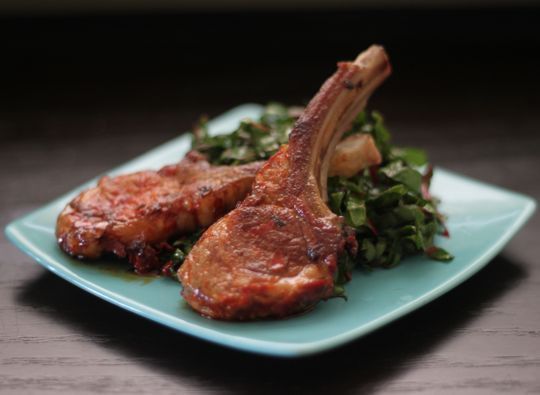 It’s a bit of a mystery why raw kale salads took off with the popularity they did and raw Swiss chard salads have yet to catch on. Raw Swiss chard greens are tender and milder in flavor than you might think. The stems are edible and have a pleasantly crunchy texture and tart flavor. Not a fan of cooked Swiss chard? There’s a good chance you’ll like it better raw. The leaves have a light and lemony flavor with very little of the astringent bitterness of cooked Swiss chard.
It’s a bit of a mystery why raw kale salads took off with the popularity they did and raw Swiss chard salads have yet to catch on. Raw Swiss chard greens are tender and milder in flavor than you might think. The stems are edible and have a pleasantly crunchy texture and tart flavor. Not a fan of cooked Swiss chard? There’s a good chance you’ll like it better raw. The leaves have a light and lemony flavor with very little of the astringent bitterness of cooked Swiss chard.
It’s that light and lemony flavor that pairs so well with something meatier, heavier and spicier like harissa lamb chops. The flavor combination of harissa lamb chops and raw Swiss chard salad is pretty much perfect. Plus, you’re getting ample amounts of vitamins K, A, C and E, magnesium and fiber from the powerhouse green, plus iron, niacin, zinc, B vitamins and conjugated linoleic acid from the lamb. What more do you need from a meal?
Harissa is a fiery hot sauce made from dried chiles, garlic, cumin, coriander, caraway and olive oil. It’s fairly easy to find harissa in grocery stores, but also easy to make at home. When you make it, you can control the heat level and play around with different types of dried chiles. Possibilities include guajillo and new mexico (medium spiciness), ancho (spicy but fruity), arbol (spicier), chipotle (smoky).
Harissa is great as a hot sauce but possibility better as a rub for meat (especially lamb). The spiciness mellows as the meat cooks and what’s left behind is rich, earthy, sweet, smoky flavor.
Servings: 4
Time in the Kitchen: 1.5 hours
Harissa Ingredients:
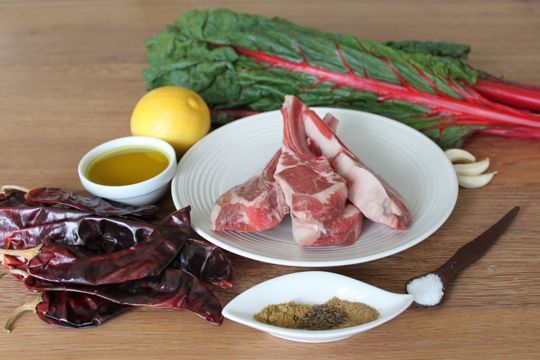
8 dried chiles, stemmed and seeded
2 to 4 garlic cloves, chopped
1/2 teaspoon kosher salt (2.5 ml)
2 tablespoons olive oil (30 ml)
3/4 teaspoon ground coriander (3.7 ml)
1/2 teaspoon ground cumin (2.5 ml)
1/2 teaspoon caraway seeds (2.5 ml)
Harissa Instructions:
Soak the dried chiles in hot water for 20 minutes. Drain.
In a food processor combine the chiles, garlic, salt, olive oil, coriander, cumin and caraway. Blend until very smooth.
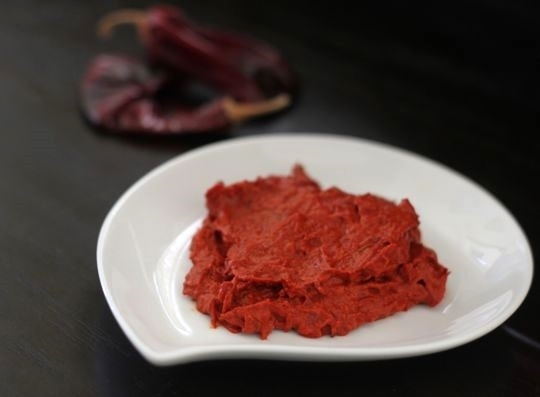
Kept in a covered container in the refrigerator with a thin layer of olive oil poured on top, harissa will keep for about a month.
Swiss Chard Salad with Baby Lamb Rib Chops Ingredients:
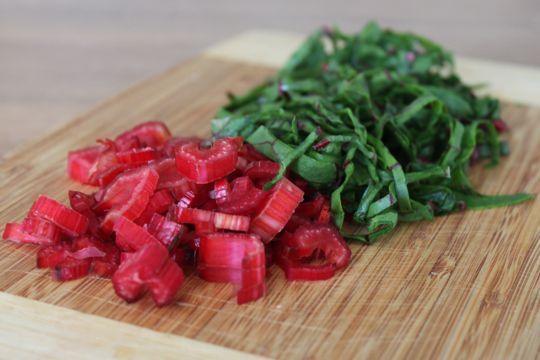
2 small bunches of Swiss chard, leaves pulled from the stems. Slice the leaves into thin strips (1/8-inch) and thinly slice the stems.
Juice from one lemon
1/4 cup extra virgin olive oil (60 ml)
1 clove garlic, finely chopped
1/4 teaspoon salt (2.5 ml)
12 baby lamb rib chops
Harissa
Instructions:
Whisk together the lemon juice, olive oil, garlic and salt. In a large bowl, pour the dressing over the Swiss chard, massaging the dressing into the leaves really well. This can be done up to 24 hours before serving the salad.
Rub about 1 teaspoon (5 ml) of harissa into each lamb chop. Lightly salt the meat and let it marinate at room temperature for 30 minutes.
Preheat the oven to 250 °F (121 °C).
Using a cast iron or other oven proof pan, warm a little coconut or olive oil over medium-high heat until very hot. Add the lamb chops and sear for 2 minutes before flipping the chops over and searing the other side for another 2 minutes. Each side should be nicely browned before being flipped.
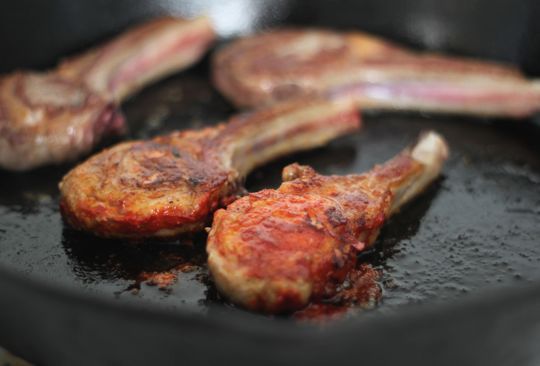
The chops can stay on the stove to cook until done, or if they’re getting too brown transfer the pan to the preheated oven and continue cooking the lamb until a digital thermometer registers around 135 °F (57 °C) (for medium-rare).
Serve the harissa lamb chops next to the raw Swiss chard salad.

Not Sure What to Eat? Get the Primal Blueprint Meal Plan for Shopping Lists and Recipes Delivered Directly to Your Inbox Each Week




May 23, 2014
How I Lost 40 Pounds and Banished Rosacea Using Primal Principles
It’s Friday, everyone! And that means another Primal Blueprint Real Life Story from a Mark’s Daily Apple reader. If you have your own success story and would like to share it with me and the Mark’s Daily Apple community please contact me here. I’ll continue to publish these each Friday as long as they keep coming in. Thank you for reading!
 Like many others who’ve jumped on the Paleo/Primal eating concept, I didn’t quite start following the regimen for weight loss. My issues stemmed from the life halting condition (which I believe to be an autoimmune condition) rosacea. For those who aren’t familiar with the condition, rosacea is an inflammatory skin disease known to have an effect on facial flushing and redness. In my case, it got to be pretty bad. Now to most people, including family and friends, this wasn’t such a big deal. So I had a bit of redness going on in my face… so what? Everyone flushes from time to time. But for me, it was an incredibly life halting experience that, for the time I had it, completely derailed my entire life.
Like many others who’ve jumped on the Paleo/Primal eating concept, I didn’t quite start following the regimen for weight loss. My issues stemmed from the life halting condition (which I believe to be an autoimmune condition) rosacea. For those who aren’t familiar with the condition, rosacea is an inflammatory skin disease known to have an effect on facial flushing and redness. In my case, it got to be pretty bad. Now to most people, including family and friends, this wasn’t such a big deal. So I had a bit of redness going on in my face… so what? Everyone flushes from time to time. But for me, it was an incredibly life halting experience that, for the time I had it, completely derailed my entire life.
I’ll hereby state that my condition was, in all likelihood, entirely inflicted by me. In my senior year of high school, I got swept away in the idea of gaining weight, building muscle and power-lifting. I made the jump all the way from 140 up to 180. I “beefed” or “bulked” up as some of my friends referred to it, but in all honesty, I was just getting fat. None of it was lean muscle. I don’t recall where my train of thought was at the time, but some foreign instinct told me to keep eating. Bad idea. At one point or another, I stopped caring about ‘what’ I was eating and was just shoving food in my mouth every two to three hours to “preserve muscle.” I was far too swept away in my own world of “Broscience” to listen to anyone else’s nutritional advice. But I still ate my whole grains and stayed hydrated, so I was being healthy, right? It’s ironic that the whole wheat/low-fat, FDA heart healthy diet is the one that eventually did me in. Over the course of a year, it hit.
Let it be clear. I absolutely HATE these pictures, but I’m sharing them with everyone because I don’t want to hide the truth of how bad it was. Look up a definition of “inflammation” in the dictionary, and you might find these pictures. If I can come back from this, I feel anybody can, especially those with a mild case.
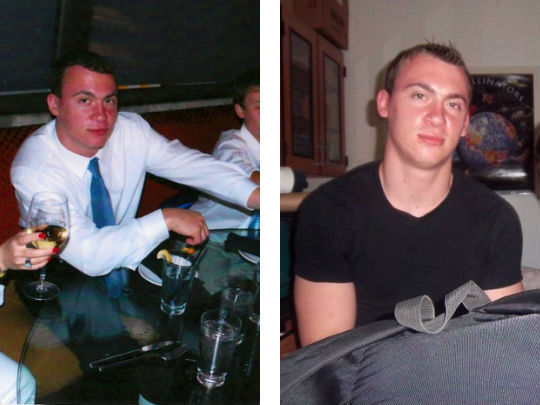
Yeah, it was bad… So as it became worse, I checked in with my dermatologist and doctor. The provided diagnosis was always, “You have dry skin, apply this cream,” and “Your skin is too oily, use this harsh chemical on your face.” Over time, I just became fed up with it. None of the creams worked. Some of them masked the symptoms to some degree, while others made them ten times worse. I wasn’t getting anywhere and this had me frustrated and about ready to give up. Self-loathing started to creep in. I was afraid to look in the mirror some days. I declined certain social events based on the status of my skin. I couldn’t look at someone and have a conversation without contemplating what my skin looked like from his or her perspective. My once robust self-confidence had been gut-shot. I became reclusive and shy. Every time I went into the sun I got sunburned. I was told there was absolutely no cure for rosacea and I’d have it forever. I was going to have to live with this embarrassing inflammation for the rest of my life.
Then I started noticing something. Every time I ate, it caused a flair up, or at least some type of small reaction with my rosacea. It became a habit of mine to routinely check how my skin reacted to certain foods. Any processed foods, foods that came in a box, or something with 3,000 ingredients – flare up. Bread, flare up. Dairy, flare up. Vegetable oils, flare up.
Slowly I began eliminating things from my diet. I kept this up for the better part of a year. My skin was getting better, but I was still nowhere near coaxing it back to its pre-rosacea state. I’d eat the same exact foods everyday as a precaution to not set off my rosacea. I literally ate nothing but lean turkey, sweet potatoes, and olive oil for almost half a year! I couldn’t live like this, but I had to find something that worked. I was getting closer to the root of the problem, but this wasn’t sustainable, nor a healthy way to live.
I was at the end of my road. Eventually I found out about gluten intolerance and paleo eating, or what I refer to now as just, “Eating food that is nourishing to my body, opposed to destroying it.” I’ll make the grand statement right here: Adapting to a high-fat/lower carbohydrate, paleo way of eating has pretty much, if not entirely, cured me of my rosacea. Why? Even after curing it, it’s hard to pinpoint exactly why rosacea comes on, but I believe, like most diseases, it starts within the gut. I think my particular case was a mixture of immune system problems, intestinal permeability, poor nutrient absorption, and SIBO (Small Intestinal Bacterial Overgrowth). Rosacea is just a sign of a deeper problem within the GI tract that needs to be corrected. Thankfully, the body is always trying to heal itself and when you take out the crap, you allow it to do so.
Here I stand today. In an attempt to be truthful to you guys, I haven’t added any “filters” or fancy Photoshop tricks to make my skin look better or cover any blemishes. (Except the last one. That one has a filter. For better or worse, this is my skin in its natural, flawed sort of-HD glory!
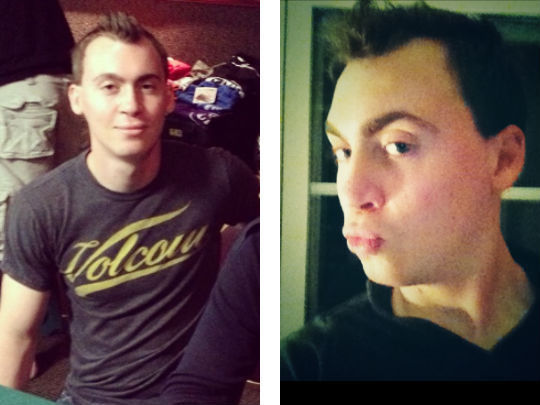
So goodbye rosacea and autoimmunity! I won’t miss you! Truthfully, this article stands as a final farewell to my condition. I’m done obsessing over my skin the way I have the past three to four years. My skin is never going to be perfect, but I need to stop thinking I can make it perfect. I’m ready to start embracing and enjoying my life again! I’m ready to tackle any opportunity that comes at me, and with rosacea, I felt I could not do this. I read a thread the other day on a separate rosacea forum entitled, “What would your life have been like had you not been diagnosed with rosacea.” What people posted was genuinely tragic and upsetting to me. People declining job opportunities, living housebound sheltered lives and ignoring intimacy, marriage, and children just because of this stupid condition. This thread was so heartbreaking to me; I felt I had to share my success story with others in the hope that I could help other people. As exciting as it is to share individual success, my biggest hope is that it reaches someone and saves them from the same trap I fell into. With that said, I’m done obsessing over the status of my skin and letting it control my life. Even with my condition in total remission, I’m still hung up on what my skin looks like on a day-to-day basis. Sometimes I want to tell myself, “Dude, relax. You’ve put it behind you! Now move forward and don’t look back!” So I’m doing that. Once again, goodbye rosacea! ☺
Additionally here are some tips or steps to follow for those who are dealing with rosacea. This is how I healed my body. I’m not going to tell you to avoid hot baths, saunas, hot weather, cold weather, spicy foods (unless you’re nightshade sensitive), etc… the typical rosacea recommendations. I don’t feel those things should play into it.
The Paleo Mom’s Autoimmune Protocol – I’m a really big fan of The Paleo Mom’s site and all she does. If I ever feel as if I’m having inflammation issues, I always have The Autoimmune Protocol to fall back on and it keeps all those issues at bay.
Eliminate Gluten, Grains & Legumes Entirely (This is a Biggie) – Never cheat with gluten. Ever! Your body will heal when you eliminate gluten, but will continue to relapse if you cheat with it from time to time. There’s no moderation here, just take it out. Every time you eat it, you’re setting yourself back and opening yourself up to a host of food allergies. Gluten is the gateway food allergy. I truly think any food intolerance I’ve ever had (dairy, nightshades, nuts) originally stemmed from gluten. Most people find that without gluten for an extended period of time, their food allergies heal. Gluten can take anywhere from a few weeks to two years to leave the system. Its effects on the gut can be devastating. When attending social events, don’t let anyone persuade you to, “just have a little.” Without gluten and grains, I’ve become free from auto-immunity at last. I’m not going to let someone who has no concern over my condition set me back and ruin the progress I’ve made in my health. Also, look out for gluten cross reactors (for me, corn is one). Have I made it clear that I absolutely hate gluten?! Good.
Eliminate Dairy – At least for a while. I’ve tried reintroducing it with grass-fed butter and the like, but it’s hard to tell if it’s giving me gut problems or not. I don’t get flare ups immediately anymore so its effects are hard to pinpoint. I was diagnosed with lactose intolerance as a kid, so maybe that factors into it? I think the casein gives me problems too. Absolutely avoid low-fat dairy. It’s gross anyway.
Eliminate Vegetable Oils
Be Mindful of Your O3:O6 Ratio – I eat a lot of oily fish, mostly salmon and sardines. I haven’t tried supplementation yet, but I might incorporate cod liver oil at some point. Especially with the cold weather rolling in. Also, more red meat like beef and lamb. I tend to eat pork and chicken too, but just not as much as the former due to O6.
Try and Eat Grass Fed
Eat More Saturated Fat and More Fat in General! – Saturated fats regulate the immune system. Fat is my highest macronutrient, sometimes getting anywhere from 60-80% of my calories from it. In the case of SIBO, you have to starve off the bad bacteria in your small intestine. Adopting a high-fat/low-carb diet disallows the sugars to reach the bad bacteria crowding the small intestine.
Bone Broth!
L-Glutamine – Best source is food, but the supplemental powder form is good for intestinal health and can help repair the damage done. L-glutamine cured my “post-meal flush” that many people with rosacea experience.
Try Gaps and SCD (Specific Carbohydrates Diet) – A lot of people with rosacea have carbohydrate intolerance. This might have to do with SIBO, pancreatic issues, and insulin. I’m honestly not sure why we have such a problem with carbs. God knows I used to eat a lot of sugar on SAD (Standard American Diet). Starch like sweet potatoes are very healing to the gut, but not particularly your best option of choice when it comes to SIBO. I really love all vegetables and most fruits (blueberries, bananas, pears, cantaloupe), and I tend to limit my fruit anywhere from 0-2 pieces a day. Usually on the weekends I’ll eat some carbs in the form of sugar. I tolerate most paleo baked goods, but avoid stuff like agave nectar. Most days I’m in ketosis, but every once in a while I’ll do the paleo cookies, cakes, etc… Just make sure they’re higher in fat for SIBO.
Stack Up On Veggies (Low FODMAP if Your SIBO Issues Are Bad) – Really go for nutrient density here. I always eat my veggies with fat for maximum absorption.
Probiotics – The only probiotics I’ve experimented with are Bubbies Sauerkraut. Be careful with probiotics in the case of SIBO, as there are particular strains you might want to avoid that could make it worse. Soil based probiotics like Prescript-Assist Broad Spectrum seem like the best choice.
HCL – Work on stomach acid. You need more of it, not less. So wean yourself off the PPI/acid reducers if you’re on them. HCL, apple cider vinegar, sauerkraut. Don’t restrict yourself from sea salt.
Sleep and Stress – I used to think these weren’t so important. VERY wrong. There’s a definite connection between the gut and stress and how much sleep you’re getting.
Don’t Scrub Your Skin Like it’s the Bathroom Floor – The best thing I ever did for my skin was to just leave it alone! Excessive exfoliating and washing only messes with your natural oil production and confuses your skin. The only thing I ever use on my skin is water and natural soaps.
Exercise – I used to do a lot of power-lifting, sometimes lifting six or several days a week. Key word: moderation. Don’t fry your central nervous system working out vigorously every single day of the week. Take the time to rest, sleep, and make sure your cortisol is well regulated. Excessive exercise and chronic cardio is a recipe for disaster. The attitude in fitness and bodybuilding nowadays is, “Push, Push, Push!!!” and “Work and train like a madman!” No. I’ve gotten better results with just keeping my diet in check and getting better sleep then I ever did spending hours in the gym.
Intermittent Fasting – Just don’t be constantly grazing on food or snacking spontaneously throughout the day. Fast every once in a while. Every so often, don’t worry about it. I usually eat three meals and a snack a day. Some days I just say, “Forget it,” and eat when I’m hungry. Nevertheless, stop the six to seven small meals a day advice.
Get Some Sun – Maybe it’s not the best to step into the sun if you’re very flared up, but we need vitamin D. Stop eating all the above-mentioned foods and you won’t get sunburned every time you expose yourself to the sun.
Finacea Gel – This is the only rosacea pharmaceutical product I can endorse. I do think it helps to some extent, but only by masking the symptoms. It’s not a cure and it’s certainly not enough to take your rosacea into remission. I use it, but if I had to choose between diet or medicinal cream, without hesitation, diet and gut health is vitally more important.
Basically, anything that’s good for your digestive and gut health is good for your rosacea!
Rob
Get the 7-Day Course on the Primal Blueprint Fundamentals for Lifelong Health Delivered to Your Inbox for FREE




May 22, 2014
The Downside of Routine: When Trying Something New Is Exactly What You Need
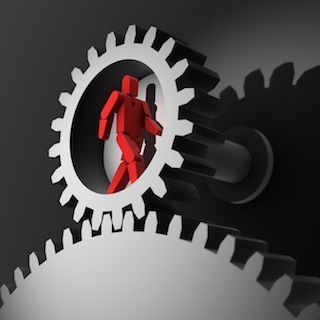 I’ll admit I’m a creature of habit in many ways. I tend to settle into routines that feel good, and I get pretty invested in them at times. (It amuses my wife.) It’s not that I don’t love to drop everything and travel to an exciting place or take a day off to do something totally out of the ordinary. In fact, my job requires me to do a lot outside of my routine, including a lot of travel and off the cuff events. All of it makes me more grateful, however, for the formula of a regular day in the home office or the traditional events around which we tend to anchor our calendar. When it comes to my Primal efforts, I likewise lean into a certain amount of routine. It’s nice to know I’m going to eat some version of the same thing for lunch. I like hitting the gym at around the same time and enjoy cycling through the pattern I often use. Routine in a similar way is especially helpful for folks who are just getting started in a lifestyle change. It can simplify the process, making it more likely they’ll stick to their intentions. Routine naturally solidifies behavior change without a lot of extra hand-wringing. All this said, there are times when it outlives its benefit in the grand scheme of health and happiness. This is where routine becomes rut – when consistency can morph into complacency. In the process, we consciously or unconsciously forgo the possibility of further progress and may even dull our awareness of what is genuinely compromising our well-being.
I’ll admit I’m a creature of habit in many ways. I tend to settle into routines that feel good, and I get pretty invested in them at times. (It amuses my wife.) It’s not that I don’t love to drop everything and travel to an exciting place or take a day off to do something totally out of the ordinary. In fact, my job requires me to do a lot outside of my routine, including a lot of travel and off the cuff events. All of it makes me more grateful, however, for the formula of a regular day in the home office or the traditional events around which we tend to anchor our calendar. When it comes to my Primal efforts, I likewise lean into a certain amount of routine. It’s nice to know I’m going to eat some version of the same thing for lunch. I like hitting the gym at around the same time and enjoy cycling through the pattern I often use. Routine in a similar way is especially helpful for folks who are just getting started in a lifestyle change. It can simplify the process, making it more likely they’ll stick to their intentions. Routine naturally solidifies behavior change without a lot of extra hand-wringing. All this said, there are times when it outlives its benefit in the grand scheme of health and happiness. This is where routine becomes rut – when consistency can morph into complacency. In the process, we consciously or unconsciously forgo the possibility of further progress and may even dull our awareness of what is genuinely compromising our well-being.
A couple of days ago I shared the results of my “no alcohol” self-experiment. Truth be told, now that I’ve enjoyed the benefits of the change, I wish I’d done it sooner. Why didn’t I? I honestly didn’t think it would matter this much. I thought the routine I had was founded on logical thinking and sound personal reasoning. After a while, I stopped questioning it. That’s generally how routine works after all. I didn’t bother bringing enough awareness or scrutiny to it.
Of course, the drawbacks of routine aren’t limited to the issues of alcohol and gut health. We often get ourselves stuck (or very comfortably situated) in a pattern and lose sight of the bigger picture. In many cases, it’s the insanity of doing the same thing expecting different results – or maybe forgetting we can (and should) expect better results than what we’re getting.
I think this is most evident in the fitness realm, where the law of diminishing returns is well understood. At the performance level (especially elite level), workout programs are obsessively scrutinized and updated, tweaked and measured with precision most of us would never think to attach to “exercise.” In that realm, however, it’s all about gaining a little more, pushing a little more, overcoming a little more, achieving a little more through various fitness training and recovery strategies. Yet, the basic principle applies to anyone. The body will physically adapt to whatever demand is put on it again and again until it doesn’t need to adapt anymore. Then it simply maintains the current level of fitness required to meet that same demand.
You see this happen every day in the gym. People will go the gym every other day for years doing the same workout (e.g. same machine even) at more or less the same intensity. After a while the improvements taper off. StairMaster Man, for example, has gotten all the benefit he’s going to get out of that drill. His body is capable of doing StairMaster. (He is StairMaster Man after all.) It’s time to move on and mix it up, but if he’s like a lot of people, he ultimately won’t. I get it. You get into a routine. It’s challenging and then later just comfortable. Life is busy, and you’re grateful just to fit in the workout time. You keep thinking you should switch it up, but every time it’s more about getting in and getting out of the gym – and getting on with the day. Maybe you change a couple minor things but nothing substantive. Next time, you say.
The same could be said for diet. You abide by the Primal Blueprint basics (or most of them, most of the time). You worked so hard to get to that point that it felt like a huge enough victory. You took a breather and devoted your energy to maintaining for a while. That while has become several months or maybe even years. Maybe you ditched sugar and gluten but still hang onto a grain or two in your diet. In another case, maybe you said goodbye to grains without a look back. You started eating clean meat and upped your vegetable and fat intake. Yet, when you look at your diet realistically, there’s plenty of open frontier to explore. There’s plenty in your routine that could be holding you back. For some of us, alcohol or caffeine doesn’t do us any favors. For others, it’s exploring more subtle food sensitivities like nightshades. If you’ve made significant changes but still have nagging symptoms or stubborn body fat levels, in most cases doing the same thing won’t be getting you different results no matter how long you keep at it. Even if the symptoms aren’t anything to write home about, do you ever wonder if those headaches are inevitable or the occasional gastrointestinal discomfort or the low grade but bothersome fatigue that hits from time to time.
For some of us, the routine factor isn’t so much an issue with the basics. We work hard at living healthily (e.g. diet, exercise), but we get stuck somewhere between living healthily and living well. Maybe it’s a job that keeps us at a desk (or in a long commute) against our ultimate wishes. Maybe it’s a family or personal schedule that doesn’t allow for optimal sleep or restoration. Maybe it’s a draining relationship or cluttered living space or a city apartment when you’d rather live in the middle of nowhere. Maybe it’s simply not feeling fulfilled socially or creatively. This matters.
So, is there something inherently wrong with simply maintaining a respectable fitness level or a good diet or moderately happy life? No, not at all. I think it bears considering, however, what we ultimately want. Have you, for example, achieved what you want in your health and well-being? I’m not talking about the castle in the cloud mentality of once upon a childhood. I mean as a conscious, mature adult who wants to thrive in this lifetime. What it means to thrive is subjective to each of us. The more salient question is this: is what we’re doing getting us there? The same old, same old will yield the same old every time. Mathematical and physiological (and often emotional) truth.
I’m not suggesting anyone reading this needs to overhaul every aspect of life (although there are plenty of MDA readers who have and couldn’t be happier with their choices). I’m not suggesting you have to upend anything major each month. What I am suggesting is this. When we let go of routine – even if it’s just an earnest mental exercise or, better yet, a period of self-experimentation – we open up what might be possible. If nothing else, we identify where some of our blind spots are, where our unquestioned assumptions and unexamined habits operate. What worked for us once might not be the best fit for us now – because of age, family situation, personal transition, health status, etc. Change for change sake can be practically productive in ways we can’t always anticipate, but it can also be profoundly life-giving. We’re creatures who are by nature drawn to novelty. How does novelty, spontaneity and experimentation live in your life now? Is it worth asking yourself whether what you’re doing now is going to give you all that you hope for? (For some of us, maybe we even need to entertain the thought that our own wishlists might set the bar too low.) In the cost-benefit ratio, where does your routine sit right now? What’s your routine done for you lately, and what can you visualize beyond it? What would life be like at a higher health “octave”? Chances are, the same old won’t get you there.
Thanks for reading, everyone. Where is routine a help, and where is it a hindrance in your life? Share your thoughts, and have a great end to the week.
Join Mark Sisson and Friends in Sunny Southern California this Sept. 25-28! Get Your Tickets for PrimalCon Oxnard 2014 Today and Finally Meet Your Tribe!




Mark Sisson's Blog
- Mark Sisson's profile
- 199 followers



